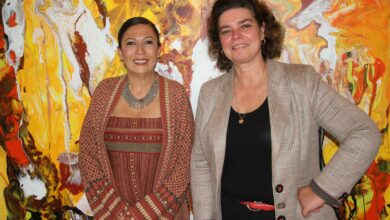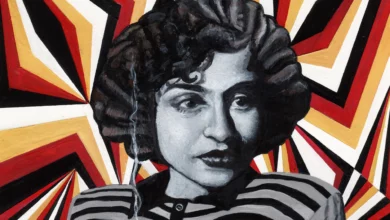In recent weeks, Alexandria’s corniche has been the site of a remarkable artistic phenomenon. Young activists have used graffiti to turn walls facing the sea into a long, decorated banner that assesses a new Egypt. The drawings, paintings and writing depict political demands that show Egypt’s revolution is not yet finished.
“It’s not art for art’s sake. It’s politics. We are telling people that the revolution is continuing and our demands still haven’t been met,” said Ranwa Youssef, a graduate student of fine arts who collaborated with her colleagues to translate political messages into art.
Egypt’s second largest city was a cornerstone to the massive protests that led to the resignation of former President Hosni Mubarak. Following his departure, Egypt's Supreme Council of Armed Forces (SCAF) took charge of the country after hailing the people’s revolt. But for the artists, this praise hasn't translated into a political commitment to abstain from despotic practices of the former regime. SCAF is accused of engaging in torture and arresting political activists.
On a wall near the famous Bibliotheca Alexandria, slogans read "Release all the political prisoners," "End state of emergency," and "The revolution is continuing."
Youssef said that after the 25 January revolution, Alexandria's artists became more organized.
"During the revolution, people used to hide in order to scribble graffiti because they were afraid of the pro-Mubarak thugs and the secret police. Now it's different. We engage in public discussions with ordinary people," she said.
People wrote on walls during the revolution to deliver political messages and call for continued protesting. Some slogans, for instance, mocked Mubarak for his wealth.
"Lied, is lying, will lie," was one slogan following a speech given by Mubarak. Written in black, with style, the slogan appeared on the wall of the Faculty of Medicine at the University of Alexandria, only meters away from Qaed Ibrahim mosque, the site of the anti-Mubarak protests in the coastal city.
Some historians trace graffiti back to the Ancient Egyptians, whose drawings on walls and rocks are considered to be among the world's oldest graffiti. Egyptologist Alexander Peden wrote about the practice in his extensive book on graffiti of Pharaonic Egypt.
But in modern times, ruling authorities viewed graffiti as more pollution than art. In 2006, the European Parliament stated, “More attention should be paid to preventing and removing dirt, litter, (and) graffiti.”
In modern Egypt, graffiti has not been used as a political tool until recently. The former regime systematically arrested young activists who failed to hide while making graffiti.
Safwan Mohamed, a 29-year-old political activist who was arrested while trying to write on walls in Alexandria, said that creating graffiti had serious consequences. In 2010, Mohamed launched a graffiti campaign called "Ana" (Me), aimed at combating the presumed ascension of Gamal Mubarak to his father's office.
"It was really dangerous for anyone who thought about writing anything on the wall. Just start writing and then you are arrested and the accusation is ready — destabilizing the regime and destroying public property," Mohamed said.
"We were using writing on the wall as a tool to tell the people that they should be aware of the inheritance project. We wrote slogans such as 'No to inheritance' and 'No to monopoly.' Now I can tell that the impact was really positive," he said.
Activists also used graffiti to call people to strike on 6 April 2008, which Facebook groups had chosen as a national day for civil disobedience against the Mubarak regime.
Both Youssef and Mohamed agree that the case of Khaled Saeed gave momentum to graffiti art in Alexandria. Saeed was allegedly beaten to death after being illegally arrested on 6 June last year by two police officers in Alexandria.
The case became a landmark in the campaign against police brutality. It also brought to life the Facebook group "We are all Khaled Saeed," which was believed to be a major player in organizing the mass anti-government protests that led to the ouster of Mubarak on 11 February.
"We used to write on the walls and asphalt political messages which indicate that we will not forget the killers of Khaled Saeed, and we will not tolerate torture," Youssef said.
"It was a success since the people were sympathizing with the case of Saeed. During the various sessions of the trial, people helped us to deliver our messages through writing on the walls," said Mohamed.
The main dilemma, he said, was that the authorities would remove the graffiti quickly, but Youssef disagreed.
"Now we are not afraid of the police and people don't see us as aliens. They perceive us as revolutionaries," she said.
However, the post-Mubarak graffiti is still in contention, Youssef said.
"During the revolution they [the Salafis] tried to remove all the graffiti that calls for a civil state. They also removed some of the paintings that portray the crescent with the cross together," she said. But in spite of the Salafi threat, residents have been enjoying the art, she said.
"By using various colors such as red, blue, black and yellow, we are trying to emphasize the artistic feature of graffiti. Why not deliver your political message in an artistic way, so people can enjoy it and interact with it?" asked Ranwa.
One mural on a wall close to the Bibliotheca Alexandria depicts a child voicing a revolutionary demand to "hold Wael Alkomy accountable." Alkomy is a notorious police officer who allegedly tortured citizens; he is also accused of killing protesters while trying to escape from a police station on 28 January, a date known as the "Day of Anger."
"We are interacting with people to tell them that we are the revolution and these drawings are part of it. These drawings tell the history of our struggle against Mubarak," Youssef said.




